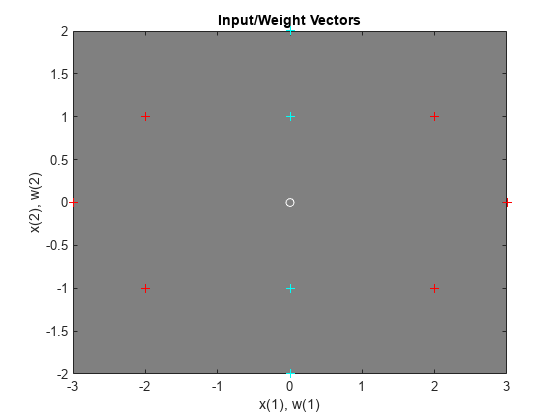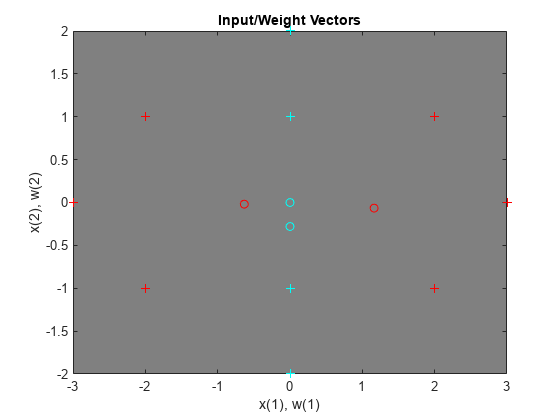학습 벡터 양자화
주어진 목표값에 따라 입력 벡터를 분류하도록 LVQ 신경망을 훈련시킵니다.
X가 2개 요소를 가진 표본 입력 벡터 10개이고 C가 이러한 벡터가 속하는 클래스라고 가정하겠습니다. 이 클래스를 IND2VEC를 사용하여 목표값 T로 쓰일 벡터로 변환할 수 있습니다.
x = [-3 -2 -2 0 0 0 0 +2 +2 +3;
0 +1 -1 +2 +1 -1 -2 +1 -1 0];
c = [1 1 1 2 2 2 2 1 1 1];
t = ind2vec(c);다음과 같이 데이터 점을 플로팅합니다. 빨간색은 클래스 1이고 녹청색은 클래스 2입니다. LVQ 신경망은 은닉 뉴런이 있는 벡터 군집을 나타내며, 출력 뉴런을 사용해서 군집을 그룹화하여 원하는 클래스를 형성합니다.
colormap(hsv); plotvec(x,c) title('Input Vectors'); xlabel('x(1)'); ylabel('x(2)');

LVQNET은 은닉 뉴런 4개를 가지며 학습률이 0.1인 LVQ 계층을 만듭니다. 그런 다음 신경망이 입력값 X와 목표값 T에 맞춰 구성됩니다. (구성은 TRAIN에 의해 자동으로 수행되므로 일반적으로 불필요한 단계입니다.)
net = lvqnet(4,0.1); net = configure(net,x,t);
경쟁 뉴런 가중 벡터는 다음과 같이 플로팅됩니다.
hold on w1 = net.IW{1}; plot(w1(1,1),w1(1,2),'ow') title('Input/Weight Vectors'); xlabel('x(1), w(1)'); ylabel('x(2), w(2)');

신경망을 훈련시키려면 먼저 디폴트 Epoch 횟수를 재정의한 다음 신경망을 훈련시키십시오. 훈련이 끝나면 입력 벡터 '+'와 경쟁 뉴런의 가중 벡터 'o'를 다시 플로팅합니다. 빨간색은 클래스 1이고 녹청색은 클래스 2입니다.
net.trainParam.epochs=150; net=train(net,x,t);

cla; plotvec(x,c); hold on; plotvec(net.IW{1}',vec2ind(net.LW{2}),'o');

이제 LVQ 신경망을 분류기로 사용합니다. 여기서는 각 뉴런이 서로 다른 범주에 대응됩니다. 입력 벡터로 [0.2; 1]을 사용합니다. 빨간색은 클래스 1이고 녹청색은 클래스 2입니다.
x1 = [0.2; 1]; y1 = vec2ind(net(x1))
y1 = 2